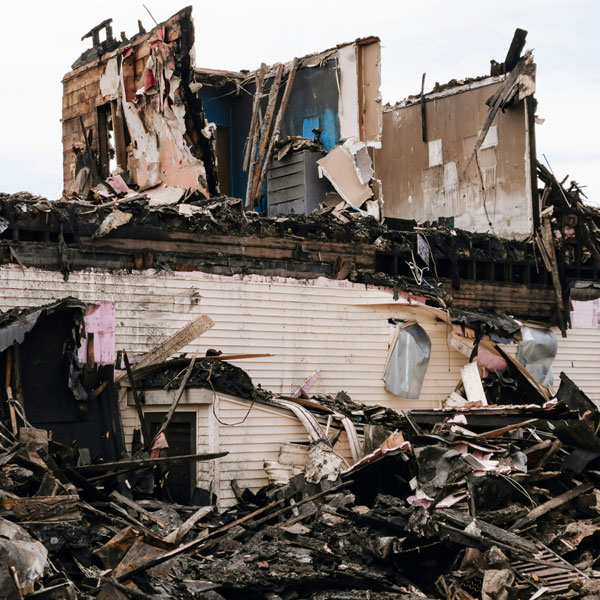Plane crash in India leaves 241 out of 242 passengers dead

[Damaged wooden infrastructure, Photo Credit to Unsplash]
On June 12, Air India Flight 171 crashed into a medical college in Ahmedabad city, claiming the lives of 241 of its 242 passengers and resulting in over 30 casualties on the ground.
The aircraft, a Boeing 787, remained airborne for no more than 40 seconds, reaching a maximum altitude of 650 feet before gradually sinking.
By the time it hit the ground, it had collided directly with a medical college, erupting into flames almost instantaneously.
At least 33 people were killed on the ground, most being medical students, but investigators are still waiting to identify their bodies.
Most casualties from this incident have yielded charred, burned bodies, with only 35 of the 241 passengers recognizable through DNA tests.
The chaos of the incident is undeniable. Vishwash Kumar Ramesh, the 40 year old sole survivor of the crash recounted, “Right in front of my eyes, I saw air hostesses, uncles, aunties dying.” Ramesh, despite remaining relatively unscathed, lost his brother Ashok to the crash.
"When I got up, there were bodies all around me. I was scared. I stood up and ran," he told The Hindustan Times. "There were pieces of the plane all around me.”
Yet, the worst of the disaster seems to have been narrowly avoided.
Sumeet Sabharwal, aged 55, was a seasoned pilot with over 8000 hours of flight hours. He and his co-pilot, Clive Kunder, have been commended for avoiding the bulk of the densely populated city.
Currently available data includes the audio of captured conversations between pilots through the cockpit voice recorder, alarms, recorded footage on the plane’s black box, and ambient sounds prior to the crash.
There is also video recorded footage by Aryan Asari, a 17 year old boy who previously was living in Ahmedabad city.
"I saw the plane. It was going down and down. Then it wobbled and crashed right before my eyes," he said, managing to film the plane on his phone just moments before the crash happened.
By coincidence, his deep passion for spotting airplanes led him to record the plane’s takeoff.
Following the accident, he underwent long hours of questioning by the police and additional had his house swamped by the media. Consequently, he has decided to return to his village home as a result of being “so disturbed” by the situation.
His father commented, “I don't think my son will try looking for airplanes in the sky again.”
Steve Scheibner, a former US navy pilot, has attributed the crash to a “dual engine failure.” As of now, remains the leading theory, though alternative causes such as hydraulic or electrical failure are also under consideration.
Regardless of, or perhaps due to, the murkiness surrounding the crash dynamics, Air India has cancelled at least 8 international flights that share the same plane model– the Boeing 787-8 Dreamliners.
They’ve cited aircraft unavailability, technical malfunctions, airspace restrictions, and extended safety checks. 3 other dreamliner flights have been grounded or delayed due to rigorous pre-flight inspections.
India’s aviation regulator has reported that there are no major safety flaws in the fleet, but the Directorate General of Civil Aviation has expressed concerns with spare-part shortages, weak internal coordination between engineering, ground handling, and operations teams.
What do we know about Ramesh’s survival? He was seated in 11A, an exit row window seat.
However, Jeff Guzzetti, former director of the Federal Aviation Administration’s Accident Investigation Division, attributes his survival to sheer luck. Only that “he was in the right place at the right time to survive this crash.”
In general, for plane crashes, “there is no predictability” in knowing who will survive.
Last December, a crash in South Korea’s Muan airport left just 2 survivors after 179 others were killed.
The possible sentiment of feeling like crashes are becoming more wide scale and commonplace is not unusual. Yet, the feeling is largely credited to our lives today being digitized.
Steve Ganyard, an ABC News aviation contributor, remarked, "Despite the terrible fatal accidents we have seen this year, 2025 has actually been safer than 2024 so far. The difference is in public perception. Everyone has the ability to record high resolution video on their smartphone and so every incident is dramatically captured.”
There are currently around 1,200 of the 787 Dreamliner aircraft worldwide and this was the first deadly crash in 16 years of operation, according to experts.
While the causes of the crash remains under investigation, it is abundantly clear that airlines around the world will take this as a sign to increase precautions, regulations, and additional measures to ensure that passengers are guaranteed safe passage to their destinations.

- Hannah Choo / Grade 11
- Korea International School Pangyo

![THE HERALD STUDENT REPORTERS [US]](/assets/images/logo_student_us.png)
![THE HERALD STUDENT REPORTERS [Canada]](/assets/images/logo_student_ca.png)
